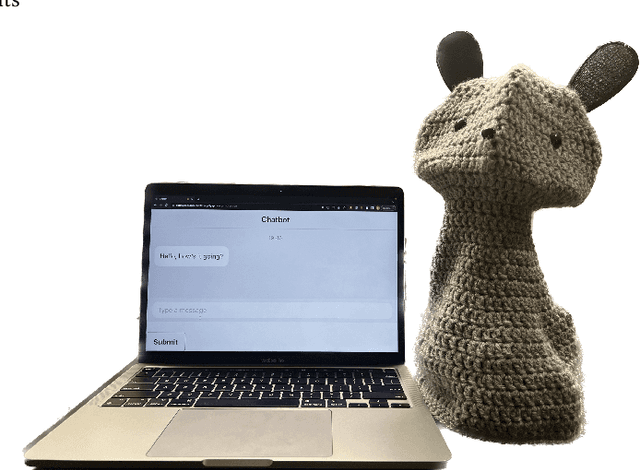Katrin Fischer
Can an LLM-Powered Socially Assistive Robot Effectively and Safely Deliver Cognitive Behavioral Therapy? A Study With University Students
Feb 27, 2024



Abstract:Cognitive behavioral therapy (CBT) is a widely used therapeutic method for guiding individuals toward restructuring their thinking patterns as a means of addressing anxiety, depression, and other challenges. We developed a large language model (LLM)-powered prompt-engineered socially assistive robot (SAR) that guides participants through interactive CBT at-home exercises. We evaluated the performance of the SAR through a 15-day study with 38 university students randomly assigned to interact daily with the robot or a chatbot (using the same LLM), or complete traditional CBT worksheets throughout the duration of the study. We measured weekly therapeutic outcomes, changes in pre-/post-session anxiety measures, and adherence to completing CBT exercises. We found that self-reported measures of general psychological distress significantly decreased over the study period in the robot and worksheet conditions but not the chatbot condition. Furthermore, the SAR enabled significant single-session improvements for more sessions than the other two conditions combined. Our findings suggest that SAR-guided LLM-powered CBT may be as effective as traditional worksheet methods in supporting therapeutic progress from the beginning to the end of the study and superior in decreasing user anxiety immediately after completing the CBT exercise.
Robot Vulnerability and the Elicitation of User Empathy
Jan 05, 2024Abstract:This paper describes a between-subjects Amazon Mechanical Turk study (n = 220) that investigated how a robot's affective narrative influences its ability to elicit empathy in human observers. We first conducted a pilot study to develop and validate the robot's affective narratives. Then, in the full study, the robot used one of three different affective narrative strategies (funny, sad, neutral) while becoming less functional at its shopping task over the course of the interaction. As the functionality of the robot degraded, participants were repeatedly asked if they were willing to help the robot. The results showed that conveying a sad narrative significantly influenced the participants' willingness to help the robot throughout the interaction and determined whether participants felt empathetic toward the robot throughout the interaction. Furthermore, a higher amount of past experience with robots also increased the participants' willingness to help the robot. This work suggests that affective narratives can be useful in short-term interactions that benefit from emotional connections between humans and robots.
* Published by and copyright protected by IEEE, 8 pages, 4 figures, 31st IEEE International Conference on Robot & Human Interactive Communication (RO-MAN 2022)
The Effect of Trust and its Antecedents on Robot Acceptance
Nov 11, 2023Abstract:As social and socially assistive robots are becoming more prevalent in our society, it is beneficial to understand how people form first impressions of them and eventually come to trust and accept them. This paper describes an Amazon Mechanical Turk study (n = 239) that investigated trust and its antecedents trustworthiness and first impressions. Participants evaluated the social robot Pepper's warmth and competence as well as trustworthiness characteristics ability, benevolence and integrity followed by their trust in and intention to use the robot. Mediation analyses assessed to what degree participants' first impressions affected their willingness to trust and use it. Known constructs from user acceptance and trust research were introduced to explain the pathways in which one perception predicted the next. Results showed that trustworthiness and trust, in serial, mediated the relationship between first impressions and behavioral intention.
 Add to Chrome
Add to Chrome Add to Firefox
Add to Firefox Add to Edge
Add to Edge